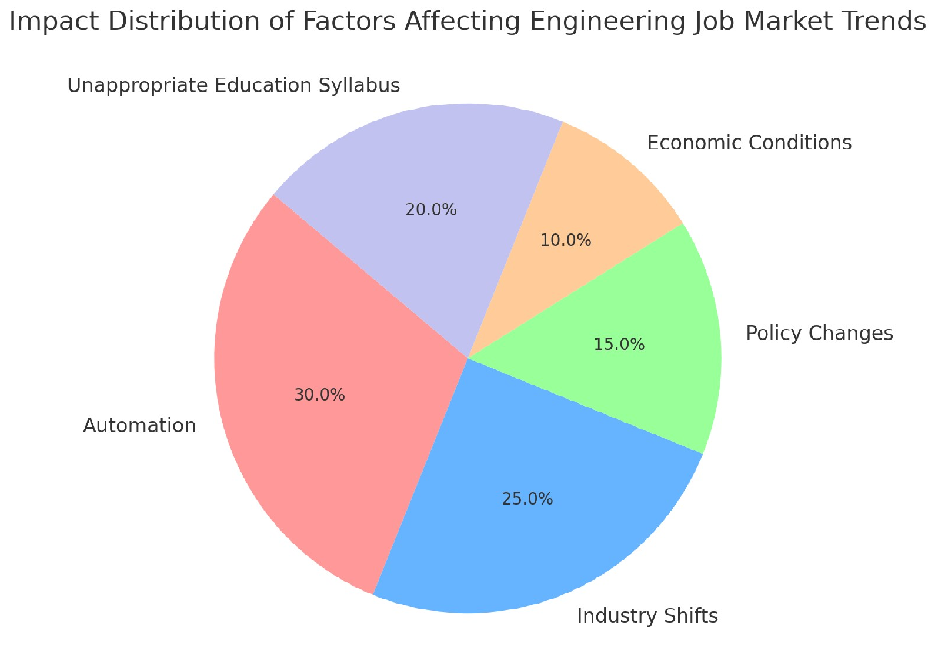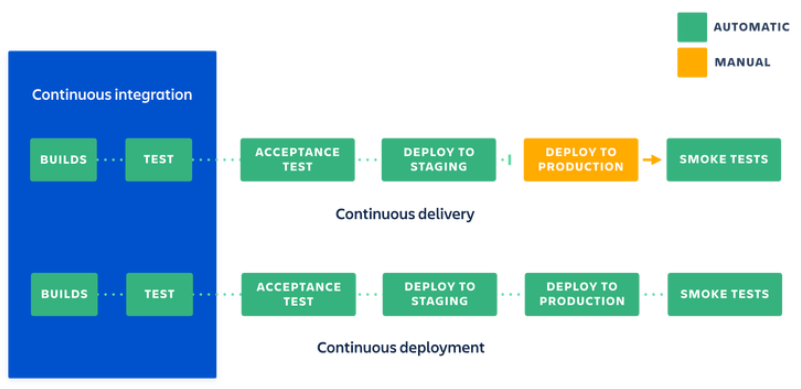User Ideas / Prospects

Elaboration on Factors Affecting Engineering Graduate Unemployment
This pie chart reflects how different factors contribute to unemployment among engineering graduates. The percentage significance of each factor is estimated based on industry reports, trends, and market analysis. Let’s break them down:
1. Automation (30%) – Most Impactful Factor
Why It’s Significant?
- Replacement of Jobs: AI, robotics, and software-driven automation are replacing traditional engineering roles in manufacturing, design, and even coding.
- Industry 4.0 Transformation: Smart factories, IoT-enabled systems, and AI-driven quality control have reduced the need for manual intervention in mechanical, electrical, and civil engineering fields.
- Software & AI in Engineering Design: With AI-powered design software, tasks that previously required teams of engineers can now be done by a single AI-assisted engineer.
Affected Fields:
- Mechanical & Electrical Engineering (due to automated manufacturing and smart grid tech).
- Civil Engineering (AI-driven construction management tools).
- Software Engineering (low-code and AI-based programming replacing entry-level developers).
Why 30%?
- Major industries (automobile, electronics, construction) are rapidly shifting towards automated processes, leading to job displacement.
- AI-driven platforms like ChatGPT, GitHub Copilot, and AI-aided simulation software are reducing demand for junior engineers.
- Reports from McKinsey, WEF, and NASSCOM estimate 30-40% of engineering jobs could be at risk due to automation.
2. Industry Shifts (25%)
Why It’s Significant?
- Some engineering fields are growing (e.g., AI, space tech, electric vehicles), while others are shrinking (e.g., petroleum, coal, conventional auto manufacturing).
- Changing Skill Requirements: Employers now demand knowledge in AI, cloud computing, cybersecurity, and automation, which traditional engineers often lack.
- Engineering Specializations Becoming Obsolete: Decline in jobs related to oil & gas, thermal power, and traditional mechanical roles.
Affected Fields:
- Chemical Engineering (reduced petrochemical industry jobs).
- Electrical Engineering (shift from traditional power grids to renewables).
- Mechanical Engineering (reduced demand for combustion engine specialists).
Why 25%?
- As per reports from World Economic Forum (WEF) & NITI Aayog, one-fourth of current engineering roles will transform within the next decade.
- Shifts in automobile (EVs vs. ICE cars), energy (solar vs. coal), and manufacturing (3D printing, robotics) have forced engineers to upskill or risk unemployment.
3. Unappropriate Education Syllabus (20%)
Why It’s Significant?
- Curriculum vs. Industry Needs Mismatch: Engineering students are still being taught outdated subjects (e.g., Fortran programming, traditional power systems) while industries need AI, cloud, IoT, and automation knowledge.
- Lack of Practical Skills: Many graduates struggle with hands-on problem-solving due to insufficient exposure to real-world engineering applications.
- No Industry-Academia Collaboration: Colleges don’t update their curriculum based on market trends, leaving graduates ill-prepared for current job demands.
Affected Fields:
- All Engineering Fields, but especially Mechanical, Civil, and Electrical Engineering, where modern software tools (like MATLAB, ANSYS, SolidWorks) are not effectively taught.
Why 20%?
- Studies from AICTE (India) and IEEE suggest nearly 50% of engineering graduates in India remain unemployed due to lack of industry-ready skills.
- Many universities take 5-10 years to update their syllabus, which lags behind fast-moving tech trends.
4. Policy Changes (15%)
Why It’s Significant?
- Governments’ Focus on Sustainability: Stricter environmental laws are reducing job availability in oil & gas, thermal power, and chemical engineering sectors.
- Limited Public Infrastructure Projects: Slower execution of government-funded projects affects civil engineers and public sector job seekers.
- Visa & Outsourcing Regulations: Countries like the USA & UK are restricting H-1B work visas, affecting Indian engineers looking for overseas jobs.
Affected Fields:
- Civil Engineering (due to slow infrastructure policy changes).
- Chemical & Petroleum Engineering (due to climate laws and bans on single-use plastics).
- Software Engineers (due to visa restrictions in major IT outsourcing countries).
Why 15%?
- Policy-driven job losses are more localized (e.g., India’s ban on plastic affects Chemical Engineers, but not all engineers).
- Government funding delays in engineering projects result in temporary employment dips rather than permanent changes.
5. Economic Conditions (10%) – Least Impactful Factor
Why It’s Significant?
- Recession & Slow GDP Growth: Global slowdowns reduce hiring across industries.
- Startup Failures: Engineering startups often fail due to funding issues, reducing hiring for young engineers.
- Pandemic Aftermath: While COVID-19 boosted some fields (biotech, software), it harmed others (aviation, manufacturing).
Affected Fields:
- Aerospace & Mechanical Engineering (due to lower aircraft demand).
- Manufacturing-based Engineers (factories shutting down post-pandemic).
Why 10%?
- Economic conditions fluctuate but do not permanently impact engineering jobs.
- Engineering is still a backbone industry, meaning it recovers faster from economic downturns compared to other sectors like retail or tourism.
Key Takeaways from the Analysis
- Automation (30%) & Industry Shifts (25%) are the top two reasons for engineering job market disruptions.
- Outdated Education Syllabus (20%) remains a major hidden cause of unemployment.
- Policy Changes (15%) & Economic Conditions (10%) play a moderate to low role in overall job availability.
- Engineers who upskill in AI, automation, and sustainable technologies will be in higher demand.
## Embracing CI/CD: Transforming Software Development
In today's fast-paced software development landscape, the demand for rapid delivery and high-quality applications has never been greater. Continuous Integration (CI) and Continuous Delivery/Deployment (CD) have emerged as essential practices that help teams meet these demands. This article explores the fundamentals of CI/CD, its benefits, and best practices for implementation.
### What is CI/CD?**
**Continuous Integration (CI)** is a development practice where code changes are automatically integrated into a shared repository several times a day. Each integration is verified by an automated build and testing process, allowing teams to detect errors quickly and improve software quality.
**Continuous Delivery (CD)** extends CI by ensuring that code changes are automatically prepared for a production release. This means that every change that passes automated tests can be deployed to production at any time, making the release process more predictable and less risky.
**Continuous Deployment** takes this a step further by automatically deploying every change that passes the tests to production, eliminating the need for manual intervention.
### Benefits of CI/CD
1. **Faster Time to Market**: By automating the integration and delivery processes, teams can release new features and updates more quickly, responding to customer needs and market changes in real time.
2. **Improved Code Quality**: Automated testing ensures that code changes are validated before they are merged, reducing the likelihood of bugs and improving overall software quality.
3. **Reduced Risk**: Smaller, incremental updates are easier to manage and roll back if issues arise. This minimizes the risk associated with large releases and helps maintain system stability.
4. **Enhanced Collaboration**: CI/CD fosters a culture of collaboration among development, operations, and quality assurance teams. Everyone works together towards a common goal of delivering high-quality software efficiently.
5. **Greater Customer Satisfaction**: With faster releases and higher quality, teams can better meet customer expectations, leading to increased satisfaction and loyalty.
### Key Components of CI/CD
1. **Version Control System (VCS)**: A VCS like Git is essential for managing code changes and facilitating collaboration among developers.
2. **Automated Build Tools**: Tools such as Jenkins, CircleCI, or GitHub Actions automate the process of compiling code and running tests, ensuring that changes are validated quickly.
3. **Automated Testing**: Implementing unit tests, integration tests, and end-to-end tests helps catch bugs early in the development process.
4. **Deployment Automation**: Tools like Kubernetes, Docker, and cloud services enable automated deployment to various environments, ensuring consistency and reliability.
5. **Monitoring and Feedback**: Continuous monitoring of applications in production allows teams to gather feedback and address issues proactively.
### Best Practices for Implementing CI/CD
1. **Start Small**: Begin with a single project or team to implement CI/CD practices. Gradually expand to other projects as the team gains experience.
2. **Automate Everything**: Aim to automate as many processes as possible, including builds, tests, and deployments. This reduces manual errors and speeds up the workflow.
3. **Maintain a Clean Codebase**: Encourage developers to write clean, maintainable code and adhere to coding standards. This makes it easier to integrate changes and reduces the likelihood of bugs.
4. **Use Feature Flags**: Implement feature flags to allow for gradual rollouts of new features. This enables teams to test new functionality in production without impacting all users.
5. **Continuously Monitor and Improve**: Regularly review CI/CD processes and gather feedback from the team. Look for areas to optimize and improve efficiency.
### Conclusion
CI/CD is not just a set of tools; it’s a cultural shift that transforms how software is developed and delivered. By embracing CI/CD practices, organizations can achieve faster delivery, improved quality, and greater collaboration among teams. As the software landscape continues to evolve, adopting CI/CD will be crucial for staying competitive and meeting the ever-changing demands of customers.
In the end, the journey to CI/CD is an ongoing process of learning and improvement, but the rewards are well worth the effort. Embrace the change, and watch your development process transform!

